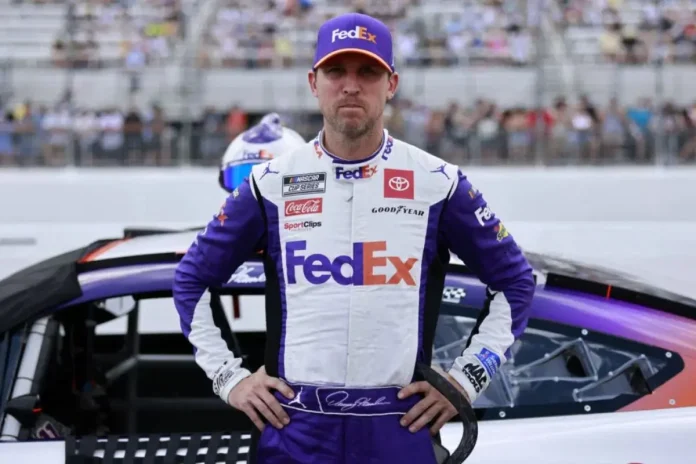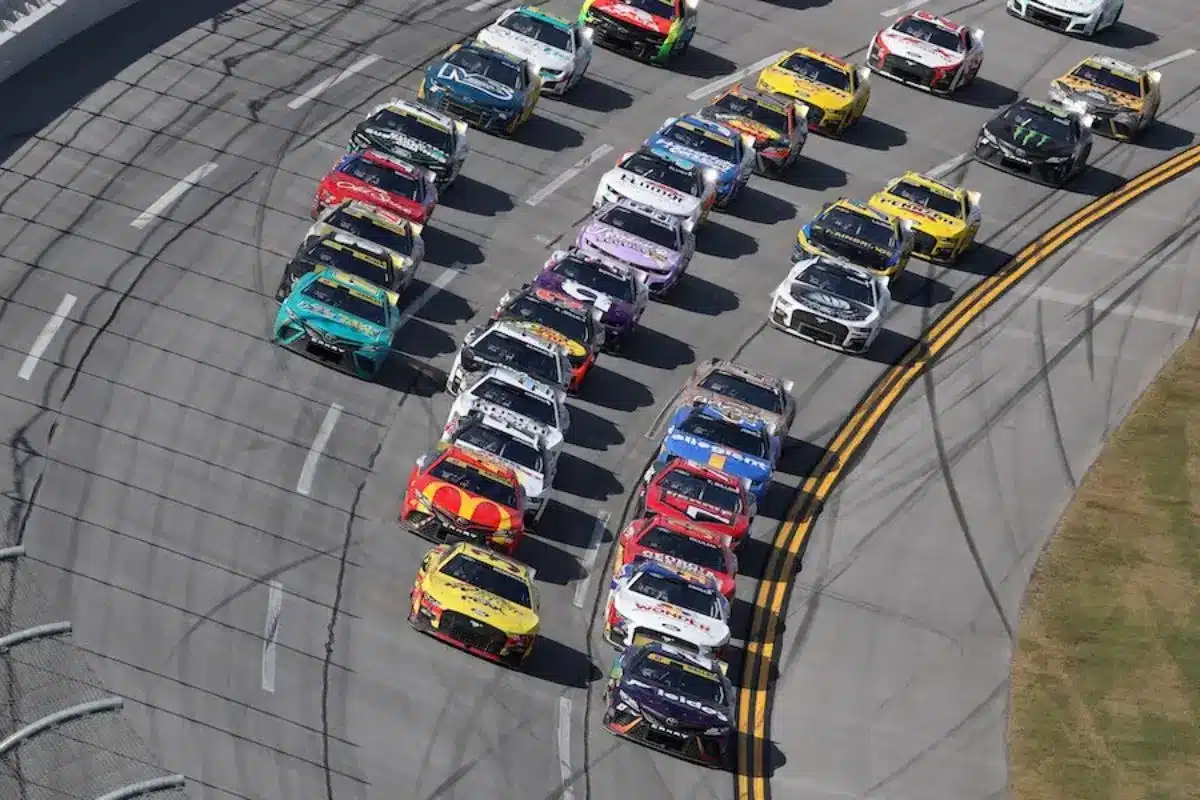Denny Hamlin Lets Out His Frustration: Denny Hamlin‘s recent comments highlight the pressing financial challenges in NASCAR, often misunderstood by fans. While multi-billion dollar television deals and brand sponsorships create a veneer of success, many teams struggle with profitability. For instance, Hendrick Motorsports hasn’t turned a profit in a decade, a glaring reality amid escalating operational costs of $20-$25 million per season.
Key Highlights
- Denny Hamlin emphasizes the disconnect between fans’ perceptions and the harsh financial realities faced by NASCAR teams.
- Successful teams like Hendrick Motorsports have not turned a profit in a decade, highlighting industry-wide financial instability.
- NASCAR’s lucrative television deal does not guarantee sustainability for all teams, leading to competitive disparities.
- The operational costs for maintaining a competitive team can reach $20-$25 million per season, straining budgets.
- Legal battles, like 23XI Racing’s lawsuit against NASCAR, reflect deeper financial tensions impacting team viability and future competitiveness.
Denny Hamlin’s Social Media Feud
Denny Hamlin’s recent foray into social media has highlighted the tumultuous relationship between NASCAR drivers and their fan base, particularly in the wake of challenges facing his team, 23XI Racing. Hamlin’s engagement on platforms like X signals a shift towards more direct communication, enabling him to express frustrations regarding the financial realities that drivers face. This pivot is not merely a personal outlet; it is indicative of a broader industry narrative where fans often remain unaware of the intricate, often unstable nature of a driver’s livelihood.
The recent publicized friction between Hamlin and Marcus Smith of SMI exemplifies a deeper issue within NASCAR—where the stakes are high, and survival becomes a central theme. As 23XI Racing grapples with potential restructuring and the implications of running as an open team by 2025, Hamlin’s reactions on social media serve as a reflection of the mounting pressure. His poignant remarks resonate with the frustrations of many within the sport, yet they also reveal his vulnerability to public sentiment.
This social media feud highlights a critical disconnect; fans may cheer for drivers without fully grasping the financial strains and systemic challenges they encounter. As Hamlin maneuvers through this delicate landscape, his candidness may be seen as a necessary confrontation with the realities of NASCAR’s evolving financial ecosystem, challenging fans to reconsider their perspectives on the drivers traversing these turbulent waters.
Denny Hamlin Defends His Position
In the midst of rising tensions and financial uncertainties, Hamlin has stepped up to firmly defend his position regarding the ongoing lawsuit filed by 23XI Racing against NASCAR. His passionate defense stems from a recognition that only a select few truly grasp the implications of the legal dispute at hand.
The charter agreement, which has been framed as a necessity for team survival, was presented to the racing teams as a “take it or leave it” ultimatum. This coercive dynamic highlights the unstable nature of financial stability within the sport.
Hamlin’s enthusiasm reflects an understanding that the stakes are extraordinarily high for 23XI Racing and its partner, Front Row Motorsports (FRM). Should the court’s decision not favor the teams, it could lead to the dissolution of their racing operations, a chilling prospect that emphasizes the lawsuit’s significance.
However, NASCAR’s recent removal of the anticompetitive release clause has opened a glimmer of hope, allowing teams to operate as open entities in 2025 while maintaining the legal challenge.
This situation demands examination and a deeper comprehension of the delicate balance involved in NASCAR’s business landscape. Hamlin’s defense serves as a clarion call for supporters and critics alike, urging them to appreciate the complexities that underpin this iconic sport.
Clarification on the Open Team Agreement
Recent developments surrounding the Open Team Agreement in NASCAR have generated considerable discussion, particularly regarding the removal of the controversial provision that previously restricted team operations. This change has been met with mixed reactions, illustrating the complexities of stakeholder interests within the sport.
Denny Hamlin recently took to social media to clarify the situation, stating, “For clarification sake. No agreement was reached. They just removed the provision.” This statement highlights the subtle yet important shift in the operational landscape for teams, which may now find themselves with more autonomy.
However, Hamlin’s comments also sparked backlash from certain fans, who accused him of entitlement. This reaction emphasizes a broader misunderstanding of the financial pressures that team owners face. Hamlin’s retort was pointed, emphasizing the risks drivers and owners undertake for the sake of competition.
“Your sense of entitlement is mind-boggling! NASCAR owes you nothing.” – nascar fans’ reaction
“So you think I should risk my health each week as a driver and risk my $ every week as an owner to put on a show for you and get nothing in return?” he challenged, drawing attention to the staggering costs of maintaining a competitive team—often between $20 to $25 million per season, excluding driver salaries.
The removal of the restrictive provision may offer some relief, but it does little to address the overarching financial model in NASCAR, which remains a point of contention. As the sport evolves, understanding these nuances becomes vital for fans and stakeholders alike.
The Open Team Agreement, while a step forward, reflects the ongoing challenges that NASCAR teams must navigate in pursuit of sustainability and success.
The Financial Realities of NASCAR Teams
Many observers may be surprised to learn that even the most successful teams in NASCAR, such as Hendrick Motorsports, have struggled with profitability in recent years. This glaring reality highlights the financial strain that permeates the sport, where competition is fierce not only on the track but also within the boardroom.
Despite Hendrick’s storied history and impressive achievements, the team has not turned a profit in a decade, casting a shadow over the financial viability of other teams within the Cup series.
The implications of this financial instability extend beyond individual teams, touching the very fabric of NASCAR as an organization. While NASCAR recently secured a staggering $7.7 billion television deal, which signals growth and potential, it is vital to recognize that the financial ecosystem is complex.
The influx of revenue from such deals does not automatically trickle down to the teams in a manner that guarantees their sustainability.
Moreover, the expansion efforts of NASCAR, aimed at broadening its audience and market share, highlight an ambitious vision. However, these initiatives may not alleviate the immediate financial burdens faced by teams like 23XI Racing or Front Row Motorsports.
The essence of the matter lies in the disparity between NASCAR’s lucrative agreements and the operational realities of the teams, which often struggle to keep pace in an environment laden with escalating costs and diminishing margins.
Update on 23XI Racing vs NASCAR Lawsuit
The ongoing legal battle between 23XI Racing and NASCAR encapsulates the broader financial tensions facing teams within the sport. Recently, NASCAR has lifted a clause in the open team agreement that previously shielded them from certain legal claims, allowing both 23XI Racing and Front Row Motorsports to compete as open teams in 2025.
This tactical maneuver is crucial, as it provides these teams a lifeline in their ongoing lawsuit, which could have been jeopardized had they signed the earlier agreement.
Despite this development, 23XI Racing’s initial motion for a preliminary injunction was dismissed by a federal court. However, the team is not backing down; they have confirmed plans to appeal this decision in the U.S. Court of Appeals.
The urgency of their situation is highlighted by their request for an expedited hearing, aiming for oral arguments to be completed between December 10-13. A typical briefing schedule would push this date to March 18-21, a timeline that is far from ideal for the team’s financial and operational plans.
NASCAR’s silence regarding the appeal request adds another layer of uncertainty, leaving Denny Hamlin and his partners in a delicate position.
As they navigate this legal landscape, the implications extend beyond 23XI Racing, underscoring the fragile balance teams must maintain within NASCAR’s evolving financial framework. The outcome of this case could set a precedent, directly impacting the operational viability and competitive landscape of the sport.
News in Brief: Denny Hamlin Lets Out His Frustration
The discussion surrounding Denny Hamlin’s comments highlights the complex financial landscape faced by NASCAR teams. A deeper understanding of the economic pressures inherent in the sport is crucial for fans to appreciate the challenges that drivers and teams encounter.
Hamlin’s confrontations on social media and his defense of the open team agreement underscore the need for transparency and communication within the NASCAR community. Ultimately, this situation serves as a reminder of the broader financial realities impacting the sport’s future.
ALSO READ: Denny Hamlin’s Twitter Clash With FOX Analyst Sparks Major NASCAR Debate





